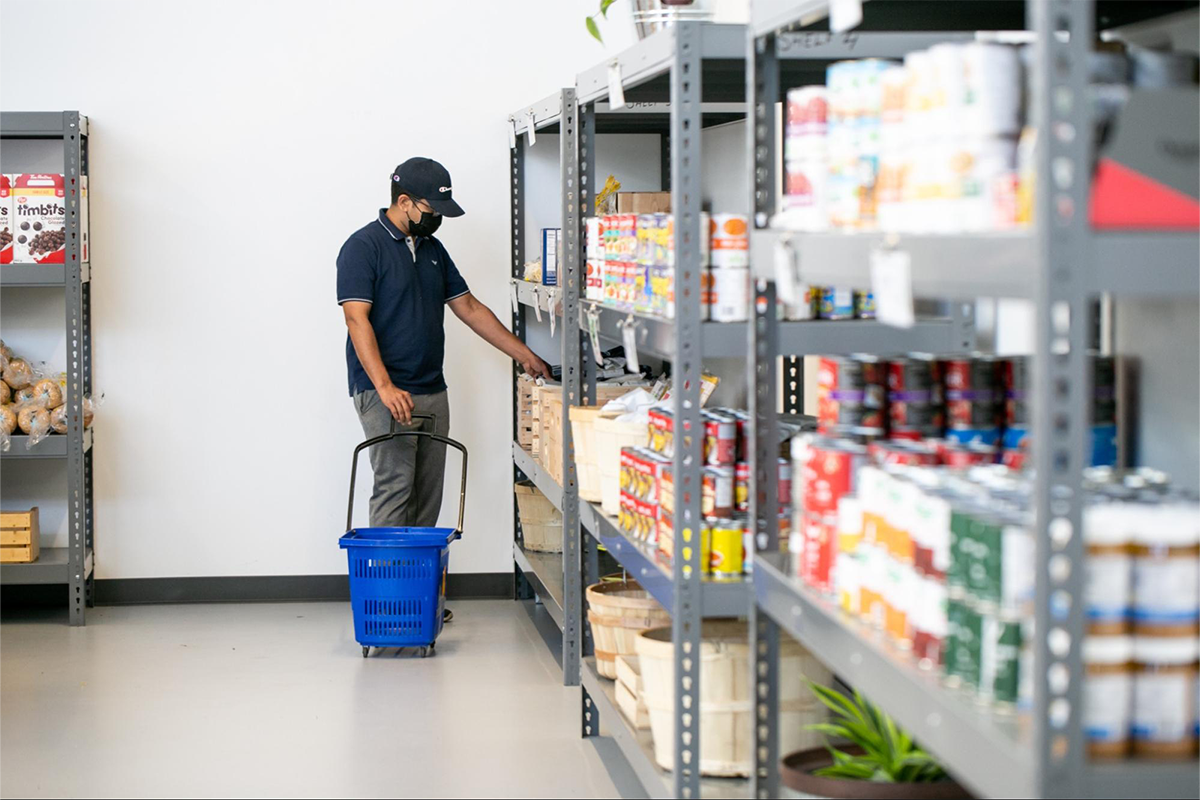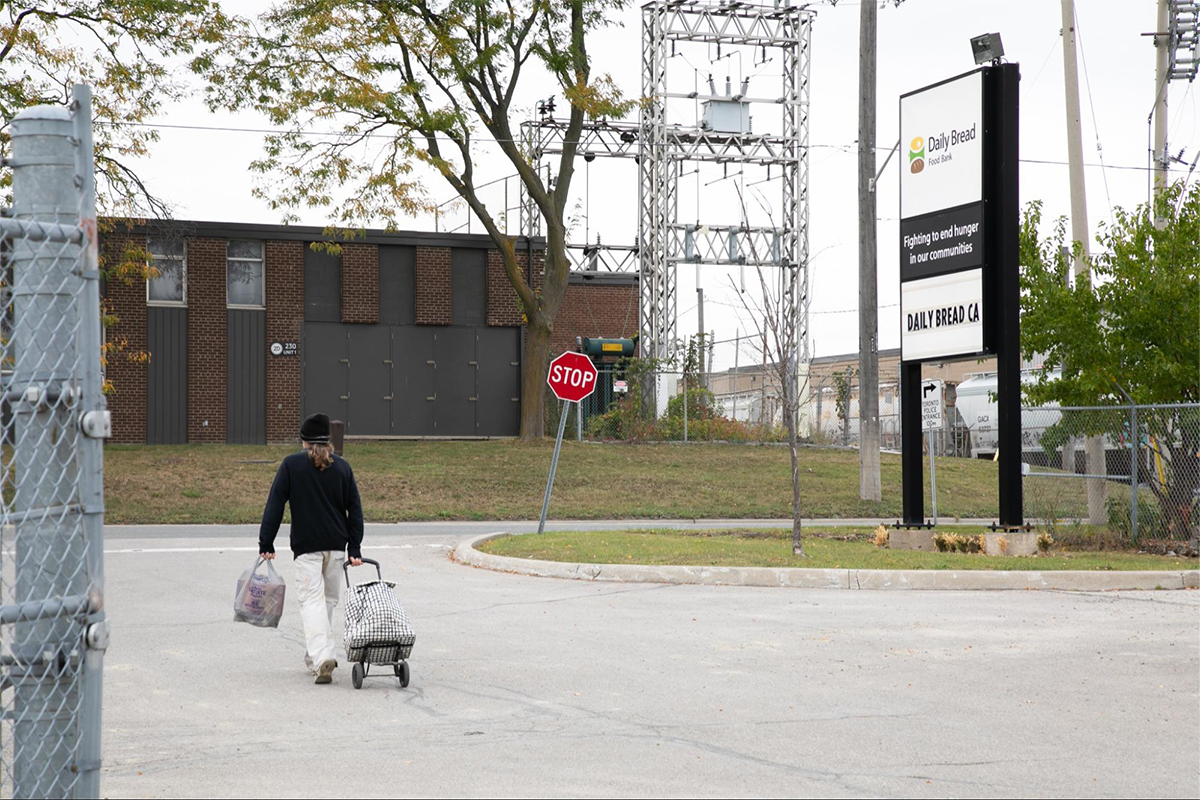Nearly 50 data-collection volunteers came together to gather insights on food insecurity in Toronto: here’s how it will transform one non-profit’s policy advocacy work
Why It Matters
Gathering information on the ground helps non-profit organizations understand issues communities grapple with in real-time, while avoiding the delays associated with government data. Training volunteers to collect this data also frees-up existing staff, giving organizations the ability to be in many places at once.

This independent journalism on data, digital transformation and technology for social impact is made possible by the Future of Good editorial fellowship on digital transformation, supported by Mastercard Changeworks™. Read our editorial ethics and standards here.
TORONTO / TREATY 13 – Former academic and community volunteer Asma Siddiqi is no stranger to data collection; while completing her doctorate at York University she spent time collecting and compiling the experiences of public library staff in Toronto. So when she heard Toronto’s Daily Bread Food Bank was looking to survey its clients to learn more about the challenges they were facing, she leapt at the chance to volunteer.
Survey in-hand, she spent three days speaking to food bank clients at the Yonge Street Mission — one of the 193 locations where Daily Bread operates a food program. But it was the organic conversations she had with clients that stuck with her most.
“They told me that the food bank runs from Tuesday to Friday, but if they come on Thursday or Friday, it has run out of everything,” says Siddiqi. “They also said that there were no staples like flour or rice.”
That kind of information is invaluable for the 40-year-old charity, which serves communities across Toronto. Research for its annual Who’s Hungry Report moved to online and telephone-based surveys during the early years of the pandemic, but with the help of 46 volunteers, the organization returned to in-person surveys this spring. Using volunteers isn’t without its challenges, but they’re essential to the complex process of researching, identifying and tracking the root causes of food insecurity — data Daily Bread then uses to inform its strategy and its advocacy.
“[The survey] gives us a barometer for food bank usage and food insecurity in the city, and we’re able to see it in a much more timely fashion than StatsCan data, which often has a two-year lag,” says Talia Bronstein, Daily Bread’s vice-president of research and advocacy.
The return to in-person data-collection was a welcome development. Bronstein says participation rates are higher with in-person surveys and clients are more likely to offer off-the-cuff observations and insights. “It makes people feel a bit more at ease when they see someone face-to-face who is interested in listening to and hearing them. They then don’t have to go out of their way to fill out an online survey or to call a centre.”
It also provides an opportunity to clarify sensitive questions around food insecurity, says Muhammad Mizanur Shuvra, a research analyst who joined Daily Bread last year and led this year’s data-collection volunteers.
Both Bronstein and Shuvra have backgrounds in statistics, but they recognize it’s a skillset many non-profits — particularly small or grassroots organizations — don’t have access to.
With the return of in-person data collection, most 2023 surveys were filled out by hand. Daily Bread outsources the data entry process, but once the responses are digitized, they’ll be analyzed using SPSS, a statistical tool.
Bronstein says Daily Bread received support from people in both public and private sector organizations, such as the City of Toronto and those working in major banks, who shared their time and expertise, enabling the food bank to create more complex statistical modeling. Free tools, like SurveyMonkey and Excel, also offer analytical tools allowing non-profits to conduct basic data analysis, and are often more financially accessible than statistical software. Complex models allow Daily Bread to draw connections between various variables that might be leading an individual towards food insecurity.
“We look at descriptive statistics, such as the percentage of people saying that they missed a meal in order to pay for something else, and what percentage of people are living in subsidized housing over rental housing,” Bronstein says. “We then look at relationships between variables – for example, how many of those who said they had a disability were missing a whole day of eating?”
Initial findings suggest food bank use, driven by inflation, has risen sharply in recent months, but the final results of the annual survey will be published in November 2023.
Survey design and deployment
With food programs located across Toronto, getting surveyors to as many locations as possible was an important consideration. Shuvra trains volunteers online, and volunteers are then encouraged to collect surveys and data independently by going to participating food banks in their own time. Relying on volunteers to work autonomously and then report back to Daily Bread allows the organization to increase its capacity, reaching food bank clients in various parts of the city and suburbs.
“We try to make sure we have proportionate representation across the city, which is representative of food bank usage in that area,” says Bronstein. “For example, if we had lower data collection in [the east Toronto area of] Scarborough, our team would either go out to fill the gap or we would do some targeted volunteer recruitment in those locations.”

The Daily Bread survey contains a mix of questions about client demographics and food bank usage. Some questions are the same every year, allowing for year-to-year data analysis and comparisons. For example, clients are asked how often they miss meals in order to pay for something else.
Clients are also asked what prompted them to visit the food bank for the first time, as well as their sources of income, including social assistance. Additionally, participants were asked standard household and demographic questions, such as age, gender identity, sexual orientation, education levels, citizenship status, disability status and racial identity.
The research team also works with a research committee to develop new questions; ones tied to current macroeconomic issues and external contexts. Daily Bread felt it was vital to ask about two specific situations in this year’s iteration of the survey: whether food bank clients received the Canada Housing Benefit and the economic circumstances of newly arrived Ukrainian refugees.
A pilot program then tested survey questions at the non-profit’s on-site food bank in the West Toronto neighbourhood of Etobicoke.
“The goal of the survey is to keep it as concise as possible, while also balancing the richness of people’s experiences,” Bronstein says.
Siddiqi notes food insecurity is deeply tied to poverty, inflation and systemic racism and says it was clear from day one that she would be collecting sensitive data on a sensitive topic. “There was some apprehension on my part because I didn’t want to use any phrases or words that would make people feel marginalized,” she says. “I was trying to find ways of presenting the questions in language that was easy to understand.”
Surveys are also available in seven languages, having been professionally translated from the original English. “That was one of the pieces of feedback we’ve received in past years and we’re looking to incrementally add more languages as we go,” says Shuvra.
There are also issues around cultural sensitivity to keep in mind when developing a survey, he points out. For instance, concepts like confidentiality and privacy don’t always easily translate into non-Western languages and cultures.
Elaine Frost, a recently-retired entrepreneur who also worked as a volunteer data collector for Daily Bread this spring, estimates between 25 and 50 per cent of those she surveyed were “recent Canadians who spoke very little English.”
The Daily Bread volunteer has been learning Spanish in her spare time and says it gave her an advantage when speaking to diverse communities. It also enlightened her on the macroeconomic situations facing immigrants, who are often welcomed by the federal government but struggle to find employment once they arrive in Canada.
Can volunteers be trained in data collection?
While he can’t be on the ground with every volunteer during the data collection process, Shuvra runs a rigorous training process before volunteers are sent into communities. “I separate the training into what the research project aims to learn, what the process is, and why it’s important, and then move into issues of [client] confidentiality and privacy,” he says.
Training covers strategies for asking sensitive questions and best practice around inquiring about an individual’s gender, race and sexuality. It also addresses how to handle client discomfort around certain questions.
Shuvra says the survey is designed to empower volunteers to ask questions in different ways, particularly questions that might be sensitive in nature. Simple questions often yield better, more robust responses, he adds.
“Every time you do a survey, you know how you can reorder or rephrase the questions,” Bronstein says, adding that staff members are often on the ground collecting data alongside volunteers and can offer assistance if it’s needed.
Frost shifted her data collection strategy over time. “I stopped asking questions and started having a conversation. The question that was most obvious to me to ask them first was not the first question on the survey, so I bounced around a little,” she says.
As a data collector, Siddiqi is very aware that her position is one of privilege. “If I was at the food bank and someone asked me about participating in a survey, I might be very angry. It’s mostly asking people about their situation and giving them hope that it might change. People are very suspicious about data collectors.”
Shuvra was also on-hand to assist throughout the data collection process, which he emphasized was important so that volunteers don’t feel uncomfortable or alone while surveying.
Bronstein describes the whole process as a “complex logistics exercise” that requires a “willingness to be nimble.”
With so many volunteers working simultaneously at so many locations, ensuring that every single survey is filled out fully and consistently is a challenge. That does have knock-on impacts on the overall quality of the data. However, “we don’t let perfection be the enemy of the good,” Bronstein says. “We don’t want to get caught up in meeting the high standards of academic rigour – this is a community research project. We’re trying to provide a forum for food bank clients to share their perspectives.”
The data is in – what happens now?
Once the data is in, Daily Bread will use it to better understand and better address the systemic issues driving hunger in Toronto. It will also inform the organization’s policy recommendations on issues like “decent work and income security,” says Bronstein.
Last year’s report found that one-third of food bank clients reported their primary source of income as employment — double the rate as the year previous — information that helped steer the non-profit’s efforts to eliminate hunger and guide its lobbying efforts.
“Our data gets used by a wide range of stakeholders,” Bronstein says. “For example, the Toronto Foundation often references our research in their annual Progress Report. A number of schools use it as a resource for teaching students about food insecurity and poverty – we are frequently contacted by students of all ages asking if they can do an interview with us for school projects – most recently, [we received a request] from a group of sixth graders.”
Data collected by Daily Bread, and used in collaboration with other organizations in the sector, helped pressure the Government of Ontario into raising provincial disability benefits by five per cent, she adds.
Shuvra likes to wrap the survey process up by providing volunteers a collective email update, but he says it’s also important to provide positive reinforcement and feedback throughout the process. “It helps them to feel ownership over the project too,” he says.

